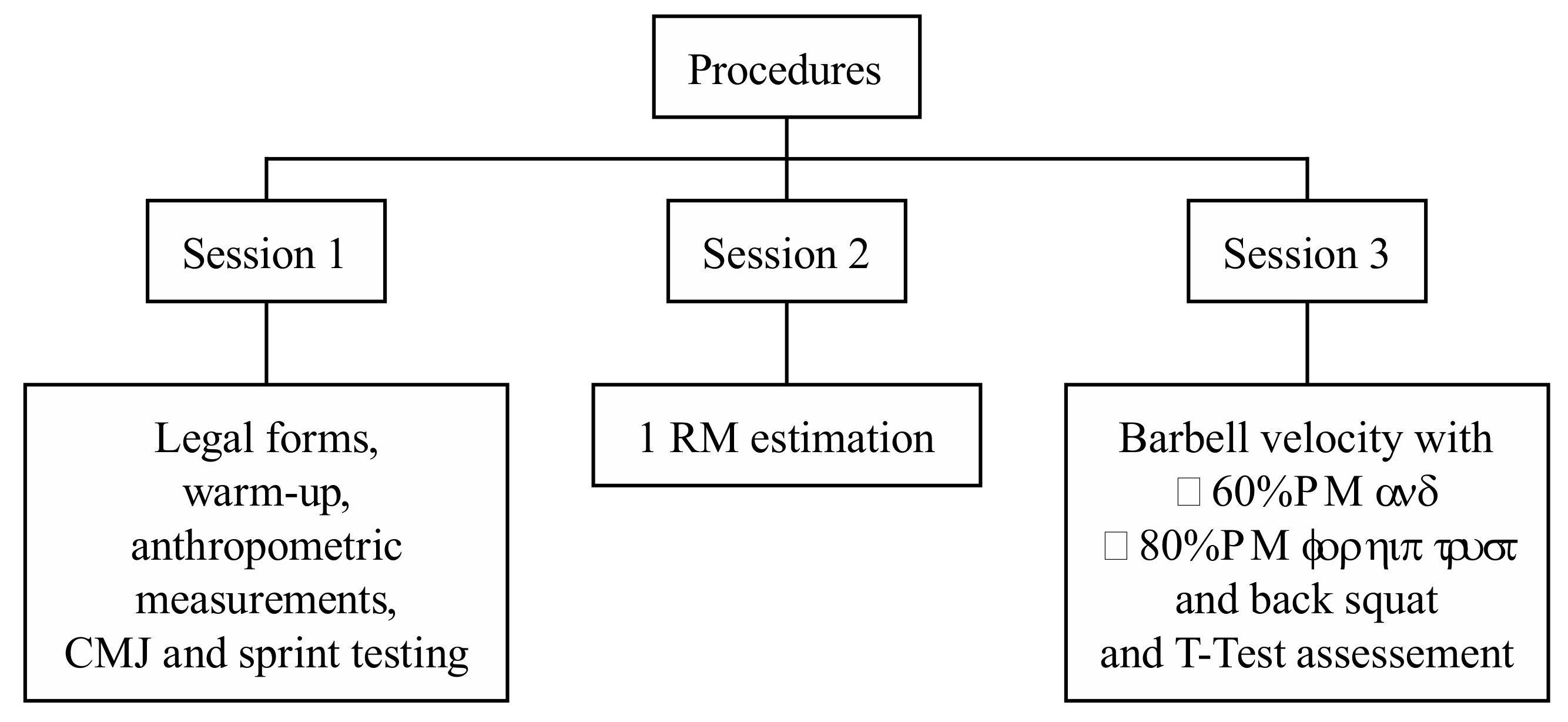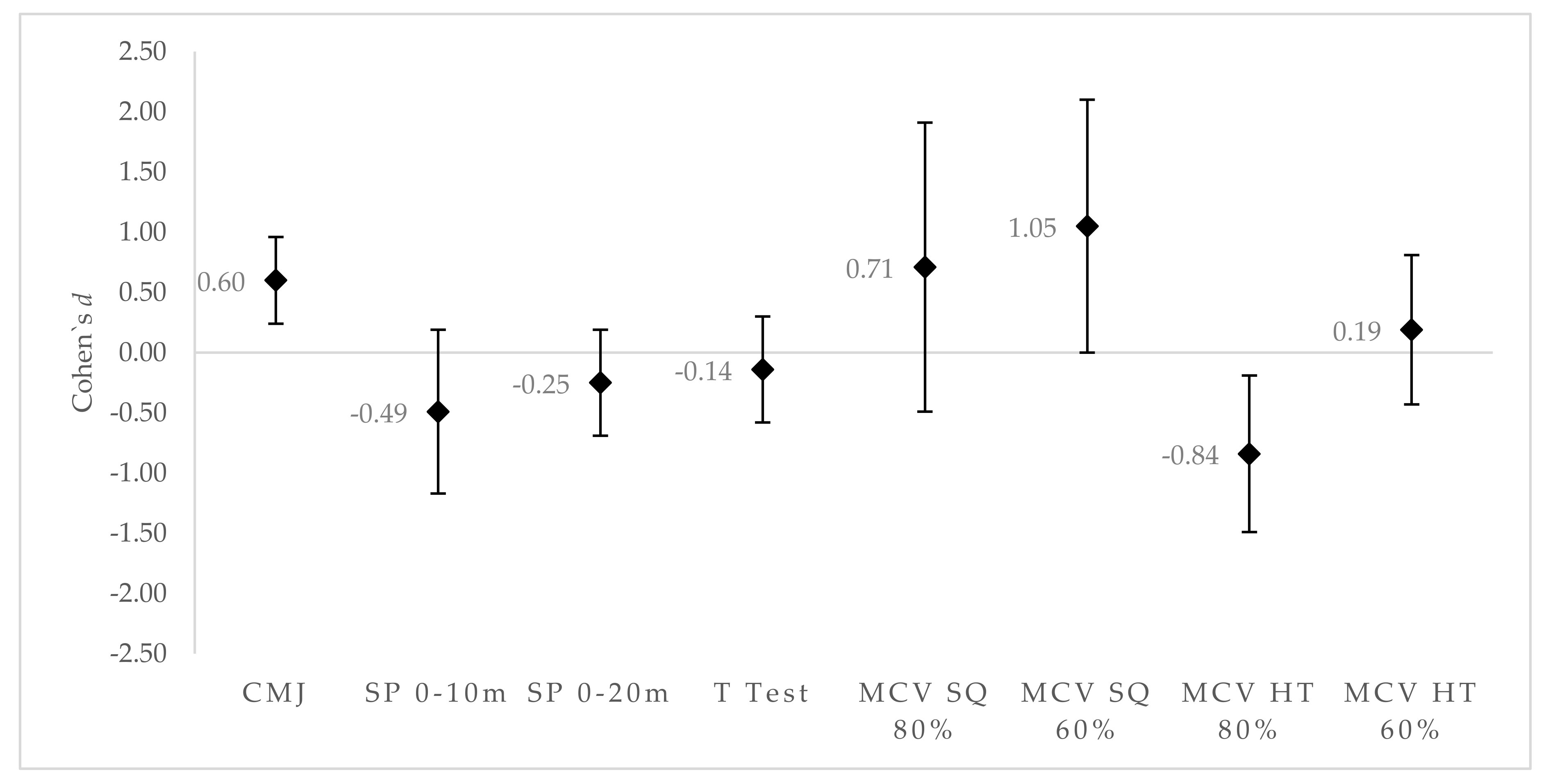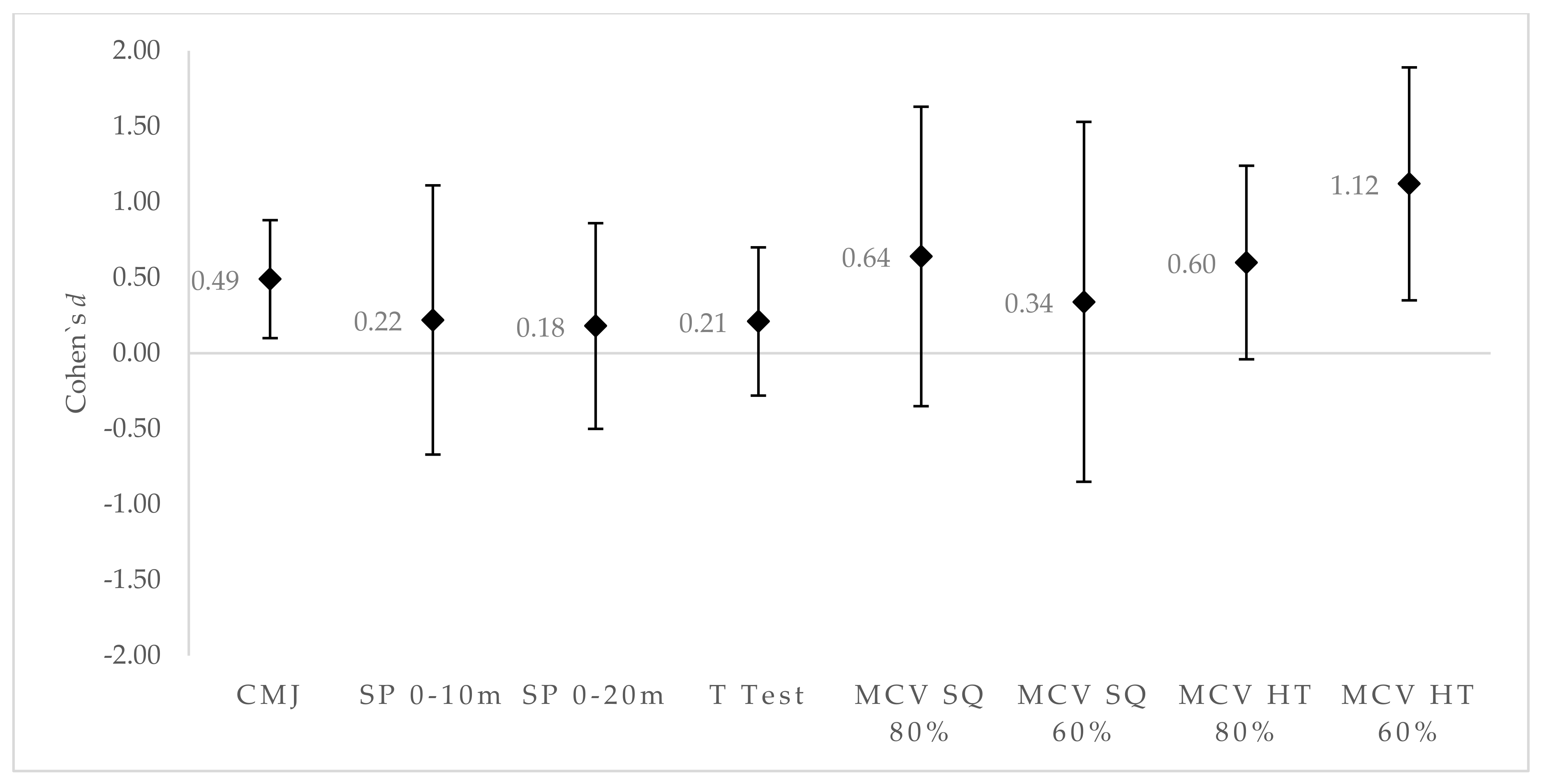Effects of 7-Week Hip Thrust Versus Back Squat Resistance Training on Performance in Adolescent Female Soccer Players
Abstract
1. Introduction
2. Materials and Methods
2.1. Study Design
2.2. Participants
2.3. Procedures
2.4. Statistical Analysis
3. Results
4. Discussion
5. Conclusions
Author Contributions
Funding
Conflicts of Interest
References
- Faude, O.; Koch, T.; Meyer, T. Straight sprinting is the most frequent action in goal situations in professional football. J. Sports Sci. 2012, 30, 625–631. [Google Scholar] [CrossRef] [PubMed]
- Deschenes, M.R.; Kraemer, W.J. Performance and physiologic adaptations to resistance training. Am. J. Phys. Med. Rehabil. 2002, 81, S3–S16. [Google Scholar] [CrossRef]
- Dello Iacono, A.; Martone, D.; Milic, M.; Padulo, J. Vertical-vs. Horizontal-Oriented Drop Jump Training: Chronic Effects on Explosive Performances of Elite Handball Players. J. Strength Cond. Res. 2017, 31, 921–931. [Google Scholar] [CrossRef] [PubMed]
- Ramírez-Campillo, R.; Gallardo, F.; Henriquez-Olguín, C.; Meylan, C.M.P.; Martínez, C.; Álvarez, C.; Caniuqueo, A.; Cadore, E.L.; Izquierdo, M. Effect of Vertical, Horizontal, and Combined Plyometric Training on Explosive, Balance, and Endurance Performance of Young Soccer Players. J. Strength Cond. Res. 2015, 29, 1784–1795. [Google Scholar] [CrossRef] [PubMed]
- Loturco, I.; Pereira, L.A.; Kobal, R.; Zanetti, V.; Kitamura, K.; Abad, C.C.; Nakamura, F.Y. Transference effect of vertical and horizontal plyometrics on sprint performance of high-level U-20 soccer players. J. Sports Sci. 2015, 33, 2182–2191. [Google Scholar] [CrossRef] [PubMed]
- Arcos, A.L.; Yanci, J.; Mendiguchia, J.; Salinero, J.J.; Brughelli, M.; Castagna, C. Short-term training effects of vertically and horizontally oriented exercises on neuromuscular performance in professional soccer players. Int. J. Sports Physiol. Perform. 2014, 9, 480–488. [Google Scholar] [CrossRef] [PubMed]
- Gonzalo-Skok, O.; Tous-Fajardo, J.; Valero-Campo, C.; Berzosa, C.; Bataller, A.V.; Arjol-Serrano, J.L.; Moras, G.; Mendez-Villanueva, A. Eccentric Overload Training in Team-Sports Functional Performance: Constant Bilateral Vertical vs. Variable Unilateral Multidirectional Movements. Int. J. Sports Physiol. Perform. 2016, 12, 951–958. [Google Scholar] [CrossRef]
- Kun-Han, L.; Chih-Min, W.; Yi-Ming, H.; Zong-Yan, C. Effects of Hip Thrust Training on the Strength and Power Performance in Collegiate Baseball Players. J. Sport Sci. 2017, 5, 178–184. [Google Scholar] [CrossRef]
- Bishop, C.; Cassone, N.; Jarvis, P.; Turner, A.; Chavda, S.; Edwards, M. Heavy Barbell Hip Thrusts Do Not Effect Sprint Performance. J. Strength Cond. Res. 2017, 31. [Google Scholar] [CrossRef]
- Contreras, B.; Vigotsky, A.D.; Schoenfeld, B.J.; Beardsley, C.; McMaster, D.T.; Reyneke, J.H.; Cronin, J.B. Effects of a Six-Week Hip Thrust vs. Front Squat Resistance Training Program on Performance in Adolescent Males: A Randomized Controlled Trial. J. Strength Cond. Res. 2017, 31, 999–1008. [Google Scholar] [CrossRef]
- De Hoyo, M.; Gonzalo-Skok, O.; Sañudo, B.; Carrascal, C.; Plaza-Armas, J.R.; Camacho-Candil, F.; Otero-Esquina, C. Comparative Effects of In-Season Full-Back Squat, Resisted Sprint Training, and Plyometric Training on Explosive Performance in U-19 Elite Soccer Players. J. Strength Cond. Res. 2016, 30, 368–377. [Google Scholar] [CrossRef] [PubMed]
- Fitzpatrick, D.A.; Cimadoro, G.; Cleather, D.J. The Magical Horizontal Force Muscle? A Preliminary Study Examining the “Force-Vector” Theory. Sports 2019, 7, 30. [Google Scholar] [CrossRef] [PubMed]
- Chelly, M.S.; Fathloun, M.; Cherif, N.; Ben Amar, M.; Tabka, Z.; Van Praagh, E. Effects of a back squat training program on leg power, jump, and sprint performances in junior soccer players. J. Strength Cond. Res. 2009, 23, 2241–2249. [Google Scholar] [CrossRef]
- Contreras, B.; Cronin, J.; Schoenfeld, B. Barbell Hip Thrust. Strength Cond. J. 2011, 33, 58–61. [Google Scholar] [CrossRef]
- Contreras, B.M.; Cronin, J.B.; Schoenfeld, B.J.; Nates, R.J.; Sonmez, G.T. Are all hip extension exercises created equal? Strength Cond. J. 2013, 35, 17–22. [Google Scholar] [CrossRef]
- Schoenfeld, B.J. Squatting kinematics and kinetics and their application to exercise performance. J. Strength Cond. Res. 2010, 24, 3497–3506. [Google Scholar] [CrossRef]
- Seitz, L.B.; Reyes, A.; Tran, T.T.; de Villarreal, E.S.; Haff, G.G. Increases in Lower-Body Strength Transfer Positively to Sprint Performance: A Systematic Review with Meta-Analysis. Sport Med. 2014, 44, 1693–1702. [Google Scholar] [CrossRef]
- Contreras, B.; Vigotsky, A.D.; Schoenfeld, B.J.; Beardsley, C.; Cronin, J. A comparison of gluteus maximus, biceps femoris, and vastus lateralis electromyographic activity in the back squat and barbell hip thrust exercises. J. Appl. Biomech. 2015, 31, 452–458. [Google Scholar] [CrossRef]
- Morin, J.B.; Bourdin, M.; Edouard, P.; Peyrot, N.; Samozino, P.; Lacour, J.R. Mechanical determinants of 100-m sprint running performance. Eur. J. Appl. Physiol. 2012, 112, 3921–3930. [Google Scholar] [CrossRef] [PubMed]
- Mendiguchia, J.; Martinez-Ruiz, E.; Edouard, P.; Morin, J.; Martinez-Martinez, F.; Idoate, F.; Mendez-Villanueva, A. A Multifactorial, Criteria-based Progressive Algorithm for Hamstring Injury Treatment. Med. Sci. Sport Exerc. 2017, 49, 1482–1492. [Google Scholar] [CrossRef]
- Mendiguchia, J.; Martinez-Ruiz, E.; Morin, J.B.; Samozino, P.; Edouard, P.; Alcaraz, P.E.; Esparza-Ros, F.; Mendez-Villanueva, A. Effects of hamstring-emphasized neuromuscular training on strength and sprinting mechanics in football players. Scand. J. Med. Sci. Sport 2015, 25. [Google Scholar] [CrossRef]
- Jiménez-Reyes, P.; Samozino, P.; García-Ramos, A.; Cuadrado-Peñafiel, V.; Brughelli, M.; Morin, J.B. Relationship between vertical and horizontal force-velocity-power profiles in various sports and levels of practice. PeerJ 2018, 6, e5937. [Google Scholar] [CrossRef]
- Wang, R.; Hoffman, J.R.; Tanigawa, S.; Miramonti, A.A.; La Monica, M.B.; Beyer, K.S.; Church, D.D.; Fukuda, D.H.; Stout, J.R. Isometric Mid-Thigh Pull Correlates with Strength, Sprint and Agility Performance in Collegiate Rugby Union Players. J. Strength Cond. Res. 2016, 30, 3051–3056. [Google Scholar] [CrossRef]
- Stewart, A.D.; Marfell-Jones, M.; De Ridder, J.H. International Standards for Anthropometric Assessment; International Society for the Advancement of Kinanthropometry: Wellington, New Zealand, 2011; pp. 1–139. [Google Scholar]
- Balsalobre-Fernandez, C.; Glaister, M.; Lockey, R.A. The validity and reliability of an iPhone app for measuring vertical jump performance. J. Sports Sci. 2015, 33. [Google Scholar] [CrossRef] [PubMed]
- Samozino, P.; Morin, J.B.; Hintzy, F.; Belli, A. A simple method for measuring force, velocity and power output during squat jump. J. Biomech. 2008, 41, 2940–2945. [Google Scholar] [CrossRef] [PubMed]
- Balsalobre-Fernández, C.; Marchante, D.; Baz-Valle, E.; Alonso-Molero, I.; Jiménez, S.L.; Muñóz-López, M. Analysis of wearable and smartphone-based technologies for the measurement of barbell velocity in different resistance training exercises. Front. Physiol. 2017, 8. [Google Scholar] [CrossRef]
- González-Badillo, J.J.; Sánchez-Medina, L. Movement velocity as a measure of loading intensity in resistance training. Int. J. Sports Med. 2010, 31, 347–352. [Google Scholar] [CrossRef]
- Balsalobre-Fernández, C.; Marchante, D.; Muñoz-López, M.; Jiménez, S.L. Validity and reliability of a novel iPhone app for the measurement of barbell velocity and 1RM on the bench-press exercise. J. Sports Sci. 2017, 36, 64–70. [Google Scholar] [CrossRef] [PubMed]
- Balsalobre-Fernández, C.; Kuzdub, M.; Poveda-Ortiz, P.; Campo-Vecino, J.D. Validity and Reliability of the Pushtm Wearable Device to Measure Movement Velocity During the Back Squat Exercise. J. Strength Cond. Res. 2015, 30. [Google Scholar] [CrossRef]
- Cohen, J. Statistical Power Analysis for the Behavioral Sciences; Lawrence Erlbaum Associates: New York, NY, USA, 1988; p. 567. [Google Scholar]
- Hopkins, W.G. A Spreadsheet for deriving a confidence interval, mechanistic inference and clinical inference from a P value. Sportscience 2007, 11, 16–20. [Google Scholar]
- Hartmann, H.; Wirth, K.; Klusemann, M.; Dalic, J.; Matuschek, C.; Schmidtbleicher, D. Influence of Squatting Depth on Jumping Performance. J. Strength Cond. Res. 2012, 26, 3243–3261. [Google Scholar] [CrossRef]
- Marshall, B.M.; Moran, K.A. Biomechanical Factors Associated with Jump Height: A Comparison of Cross-Sectional and Pre-to-Posttraining Change Findings. J. Strength Cond. Res. 2015, 29, 3292–3299. [Google Scholar] [CrossRef] [PubMed]
- Hunter, J.P.; Marshall, R.N.; McNair, P.J. Relationships between ground reaction force impulse and kinematics of sprint-running acceleration. J. Appl. Biomech. 2005, 21, 31–43. [Google Scholar] [CrossRef] [PubMed]
- Morin, J.B.; Gimenez, P.; Edouard, P.; Arnal, P.; Jiménez-Reyes, P.; Samozino, P.; Brughelli, M.; Mendiguchia, J. Sprint acceleration mechanics: The major role of hamstrings in horizontal force production. Front. Physiol. 2015, 6, 404. [Google Scholar] [CrossRef] [PubMed]
- Sheppard, J.M.; Young, W.B. Agility literature review: Classifications, training and testing. J. Sports Sci. 2006, 24, 919–932. [Google Scholar] [CrossRef]
- Spiteri, T.; Newton, R.U.; Binetti, M.; Hart, N.H.; Sheppard, J.M.; Nimphius, S. Mechanical Determinants of Faster Change of Direction and Agility Performance in Female Basketball Athletes. J. Strength Cond. Res. 2015, 29, 2205–2214. [Google Scholar] [CrossRef]
- Emmonds, S.; Nicholson, G.; Beggs, C.; Jones, B.; Bissas, A. Importance of physical qualities for speed and change of direction ability in elite female soccer players. J. Strength Cond. Res. 2017, 31. [Google Scholar] [CrossRef]
- De Hoyo, M.; Pozzo, M.; Sanudo, B.; Carrasco, L.; Gonzalo-Skok, O.; Dominguez-Cobo, S.; Morán-Camacho, E. Effects of a 10-week In-Season Eccentric Overload Training Program on Muscle Injury Prevention and Performance in Junior Elite Soccer Players. Int. J. Sport Physiol. Perform. 2014, 10, 46–52. [Google Scholar] [CrossRef]
- Bryanton, M.A.; Kennedy, M.D.; Carey, J.P.; Chiu, L.Z.F. Effect of squat depth and barbell load on relative muscular effort in squatting. J. Strength Cond. Res. 2012, 26, 2820–2828. [Google Scholar] [CrossRef]
- Sung, E.; Han, A.; Hinrichs, T.; Vorgerd, M.; Manchado, C.; Platen, P. Effects of follicular versus luteal phase-based strength training in young women. Springerplus 2014, 3, 668. [Google Scholar] [CrossRef]
- Morin, J.B.; Samozino, P. Interpreting power-force-velocity profiles for individualized and specific training. Int. J. Sports Physiol. Perform. 2016, 11, 267–272. [Google Scholar] [CrossRef] [PubMed]
- Jiménez-Reyes, P.; Samozino, P.; Brughelli, M.; Morin, J.B. Effectiveness of an Individualized Training Based on Force-Velocity Profiling during Jumping. Front. Physiol. 2016, 7, 677. [Google Scholar] [CrossRef] [PubMed]



| Week 1 | Week 2 | Week 3 | Week 4 | Week 5 | Week 6 | Week 7 |
|---|---|---|---|---|---|---|
| 4 × 12 (60% RM) | 4 × 10 (70% RM) | 4 × 10 (70% RM) | 4 × 8 (80% RM) | 4 × 8 (80% RM) | 4 × 6 (85% RM) | 4 × 4 (90% RM) |
| Variables | Squat Group (n = 8) | Hip Thrust Group (n = 8) | Control Group (n = 8) | |||
|---|---|---|---|---|---|---|
| – | Mean | SD (±) | Mean | SD (±) | Mean | SD (±) |
| Mass | 58.21 | 3.83 | 59.77 | 7.37 | 54.686 | 6.19 |
| Fat% | 18.71 | 3.34 | 18.5 | 3.12 | 17.514 | 4.41 |
| Musc% | 25.2 | 3.78 | 24.54 | 2.57 | 23 | 1.68 |
| CMJ | 28.96 | 4.03 | 25.53 | 4.9 | 28.103 | 3.73 |
| Pow CMJ | 1342.11 | 209.64 | 1297.33 | 425.72 | 1348.75 | 237.14 |
| F0 | 1139 | 131.39 | 1148.31 | 281.52 | 1121.97 | 163.32 |
| V0 | 1.18 | 0.1 | 1.11 | 0.11 | 1.2 | 0.06 |
| SP 0–10 m | 1776.29 | 73.36 | 1944.29 | 92.86 | 1941.71 | 149.53 |
| SP 10–20 m | 1390.43 | 49.8 | 1451.71 | 81.42 | 1453.14 | 102.9 |
| SP 0–20 m | 3166.71 | 96.92 | 3396.00 | 135.36 | 3394.85 | 246.12 |
| T-test | 10.54 | 0.26 | 10.95 | 0.37 | 11.04 | 0.53 |
| MCV SQ 80% | 0.52 | 0.17 | 0.49 | 0.15 | 0.48 | 0.08 |
| MCV SQ 60% | 0.68 | 0.11 | 0.64 | 0.1 | 0.66 | 0.1 |
| MCV HT 80% | 0.63 | 0.19 | 0.6 | 0.16 | 0.51 | 0.15 |
| MCV HT 60% | 0.73 | 0.1 | 0.72 | 0.14 | 0.63 | 0.1 |
| Pow SQ 80% | 633.71 | 238.21 | 594.71 | 192.62 | 628.14 | 86.32 |
| Pow SQ 60% | 745.43 | 204.03 | 623.57 | 84.37 | 652.71 | 108.97 |
| Pow HT 80% | 467.43 | 139.21 | 507.5 | 199.91 | 372.43 | 103.83 |
| Pow HT 60% | 418.86 | 101.01 | 433 | 83.59 | 375.71 | 63.09 |
| Variables | Changes % | Standardized Differences | QI | Chances | |
|---|---|---|---|---|---|
| – | (90% CL) | (90% CL) | – | – | – |
| CMJ | −0.5 (−7.1;6.6) | −0.02 (−0.36;0.31) | Small | Unclear | 13/69/18 |
| Pow CMJ | −2.5 (−13.7;10.1) | −0.10 (−0.57;0.38) | Trivial | Unclear | 14/51/35 |
| F0 | −9.8 (−77.3;258.5) | −0.05 (−0.66;0.57) | Trivial | Unclear | 24/43/33 |
| V0 | −1.4 (−5.0;2.3) | −0.14 (−0.49;0.22) | Trivial | Unclear | 6/57/38 |
| SP 0–10m | 5.6 (−1.2;12.8) | 0.7 (−0.16;1.56) | Medium | Likely | 85/11/4 |
| SP10–20m | −0.1 (−4.7;4.3) | −0.02 (−0.8;0.77) | Trivial | Unclear | 31/36/34 |
| SP 0–20m | 3.1 (−1.3;7.7) | 0.46 (−0.2;1.13) | Small | Likely | 76/19/5 |
| T-test | 1.7 (0.4;3.0) | 0.36 (0.08;0.65) | Small | Likely | 84/16/0 |
| MCV SQ 80% | −1.0 (21.0;23.9) | −0.03 (−0.7;0.64) | Trivial | Unclear | 27/41/32 |
| MCV SQ 60% | −11.7 (−24.4;3.2) | −0.7 (−1.59;0.18) | Medium | Likely | 5/12/84 |
| MCV HT 80% | 20.0 (−6.8;54.4) | 0.53 (−0.2;1.27) | Medium | Likely | 78/17/5 |
| MCV HT 60% | 22.0 (2.5;45.2) | 1.02 (0.13;1.91) | High | Likely | 94/5/2 |
| Pow SQ 80% | −5.9 (−24.9;17.8) | −0.17 (−0.80;0.46) | Trivial | Unclear | 15/38/47 |
| Pow SQ 60% | −8.2 (−24.6;11.8) | −0.35 (−1.16;0.46) | Small | Unclear | 12/25/63 |
| Pow HT 80% | 0.4 (−22.1;29.4) | 0.01 (−0.55;0.57) | Trivial | Unclear | 28/47/26 |
| Pow HT 60% | 37.8 (−6.4;103.0) | 1.33 (−0.27;2.94) | High | Unclear | 89/6/6 |
© 2019 by the authors. Licensee MDPI, Basel, Switzerland. This article is an open access article distributed under the terms and conditions of the Creative Commons Attribution (CC BY) license (http://creativecommons.org/licenses/by/4.0/).
Share and Cite
González-García, J.; Morencos, E.; Balsalobre-Fernández, C.; Cuéllar-Rayo, Á.; Romero-Moraleda, B. Effects of 7-Week Hip Thrust Versus Back Squat Resistance Training on Performance in Adolescent Female Soccer Players. Sports 2019, 7, 80. https://doi.org/10.3390/sports7040080
González-García J, Morencos E, Balsalobre-Fernández C, Cuéllar-Rayo Á, Romero-Moraleda B. Effects of 7-Week Hip Thrust Versus Back Squat Resistance Training on Performance in Adolescent Female Soccer Players. Sports. 2019; 7(4):80. https://doi.org/10.3390/sports7040080
Chicago/Turabian StyleGonzález-García, Jaime, Esther Morencos, Carlos Balsalobre-Fernández, Ángel Cuéllar-Rayo, and Blanca Romero-Moraleda. 2019. "Effects of 7-Week Hip Thrust Versus Back Squat Resistance Training on Performance in Adolescent Female Soccer Players" Sports 7, no. 4: 80. https://doi.org/10.3390/sports7040080
APA StyleGonzález-García, J., Morencos, E., Balsalobre-Fernández, C., Cuéllar-Rayo, Á., & Romero-Moraleda, B. (2019). Effects of 7-Week Hip Thrust Versus Back Squat Resistance Training on Performance in Adolescent Female Soccer Players. Sports, 7(4), 80. https://doi.org/10.3390/sports7040080






